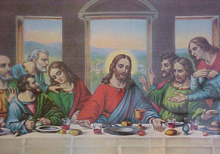 |
Olga's Gallery.
Leonardo da Vinci. The Last Supper. c.1495-1498. Oil
and
tempera on plaster. 460 x 880 cm. Santa Maria delle Grazie,
Refectory, Milan,
Italy. | |
The guide ushering tourists
into the former monks' dining hall that houses Leonardo da Vinci's faded
masterpiece "The Last Supper" tried in vain to interest her audience in
art history, technique and aesthetics.
She knew that sooner or later the questions -- about the Holy Grail's
presence or absence from the work, or the real sex of the disciple to the
right of Christ -- would come.
"Of course, you know there is now 'The Da Vinci Code'," Danish-born
interpreter Hanne Munk told the guide at the end of her 15-minute viewing
of the 30-foot-long painting, famed for its psychological realism and
innovative use of perspective.
The guide, Lidia Sanvito, nodded wearily. The 34-year-old has heard of
little else since U.S. author Dan Brown's runaway bestseller was published
in March 2003, first from American readers, then starting late last year,
from Italians and others as foreign translations hit bookstores worldwide.
"They torture me," she said of the curious visitors. "I wasn't
surprised about the Americans. But it really did shock me that Italians,
with their strong Catholic traditions, would also ask these questions."
Few who visit the 500-year-old painting have not heard of the book.
Many visitors nowadays admit the sensational tale of scheming priests, secret societies
and pagan symbols was the main reason for their visit to Santa Maria delle
Grazie church, on an otherwise quiet street in Italy's business capital.
"The Last Supper" has always been a top tourist draw in a city whose
artistic treasures pale beside those of Rome, Venice and Florence. Even in
August, when a mass holiday exodus leaves Milan virtually deserted, the
small square outside the church bustles with activity.
(Agencies) |
在導游的帶領下,游客們走進大廳,這里曾經是修道士們的食堂,如今卻收藏著里奧納多·達·芬奇的名畫《最后的晚餐》,因為年代久遠,這副名畫已有些褪色。導游想盡辦法試圖激起參觀者們對藝術史、繪畫技巧和審美學的興趣,然而結果只是徒勞。
她知道遲早會有人提出那些問題,比如作品里的圣杯是否真的存在,或者站在耶穌右邊的信徒的真實性別是什么。
丹麥籍翻譯阿納·芒克足足花了15分鐘欣賞完這幅30英尺長的名畫,這幅畫因心理寫實主義和對透視畫法的創造性使用而聞名,隨后她對導游說:“當然了,你知道現在很流行《達芬奇密碼》。”
導游利迪婭·圣維托無奈地點了點頭。自從2003年3月美國作家丹·布朗的這本暢銷書出版并獲得巨大成功以來,這位34歲的導游很少聽到人們談論這本書以外的內容。她最早是從美國讀者口中聽說的,隨后,從去年年底開始,隨著該書的翻譯版本在全球各地的書店引起轟動后,意大利和其他國家的游客也開始討論這本書。
當談起那些好奇的游客時,她說:“他們簡直是在折磨我。如果是美國人提出這些問題,我并不覺得奇怪。但是聽到有著濃厚天主教傳統的意大利人也問這樣的問題,我感到非常驚訝。”
參觀這幅有著500年歷史的名畫的游客中,很少有人沒讀過這本書。現在,很多參觀者承認,有關那些詭計多端的牧師聳人聽聞的傳說、秘密團體和異教徒的象征是他們參觀圣瑪麗亞·德·葛拉齊亞教堂的主要原因。該教堂位于意大利商業中心的一條街道上,(如果沒有游客的頻頻打擾),這條小街本該非常安靜。
在這樣一座藝術收藏和羅馬、威尼斯和佛羅倫薩相比略遜一籌的城市,《最后的晚餐》始終是這里最吸引游客目光的名畫。即使到了八月份,當大批游客的離去使米蘭變得蕭條起來時,這個教堂外面的小廣場上依然熙熙攘攘。
(中國日報網站譯) |
